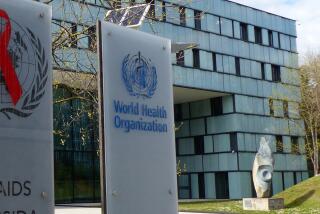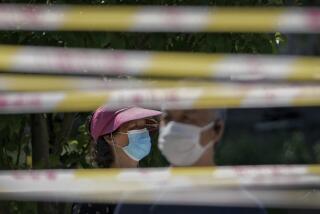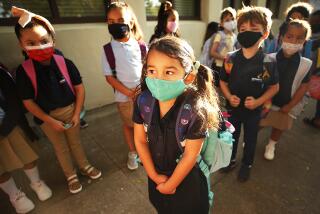Officials urge WHO to change swine flu alert criteria
As the World Health Organization inched closer Monday to raising the infectious disease alert level to its highest stage -- and to a decision on whether to manufacture a vaccine against the novel H1N1 influenza virus -- some delegates to the WHO congress in Geneva urged the agency to change its criteria for increasing the alert level.
Current rules call for the alert to be raised to Phase 6 if community transmission of the new virus is observed in two different WHO regions. So far, such transmission has been observed only in North America, which accounts for about 95% of the nearly 9,000 confirmed infections that have been observed worldwide.
But an outbreak of the virus in Japan detected over the weekend hints that such transmission may soon be observed in Asia as well. Japanese authorities said Monday in Tokyo that there have been 135 confirmed cases of H1N1 influenza in schools in Kobe and Osaka, mostly among students and family members who have not visited North America, suggesting that the virus might have been transmitted locally.
Authorities have ordered more than 1,000 schools in those cities closed in an effort to contain the outbreak.
Other pockets of infection have been observed in Spain, with 103 confirmed infections, and Britain, with 101. The WHO has been monitoring the situation closely in all three countries, but so far “we don’t see sustained community spread,” WHO spokesman Dick Thompson said.
Several cases have also been observed in South America, and officials are keeping a watchful eye there as well because the region is entering its flu season, providing fertile ground for the virus to spread.
Some delegates to the WHO congress called on the organization to change its criteria for raising the alert level to reflect the severity of the virus rather than simply transmission. So far, the virus has proved relatively mild, with 76 deaths worldwide, including six in the United States.
“We need to give you and your team [the WHO] more flexibility as to whether we move to Phase 6,” said British Health Secretary Alan Johnson in a speech to the congress.
Governments in many countries, including China, Japan and Britain, fear that raising the alert level will put more pressure on their health systems, impede international travel and cause panic even though the new strain of virus appears to be no more lethal than seasonal flu.
The United States has so far remained noncommittal, with newly installed Health and Human Services Secretary Kathleen Sebelius saying she wants to study the issue more before making a recommendation.
But WHO officials noted that severity will differ from country to country, making it hard to agree on an objective measure of the virus’ effects. Transmission, however, provides a clear, objective measure of viral spread. The criteria, moreover, were set largely in response to the avian flu virus, which is much more lethal than H1N1 but not readily transmissible among humans.
Dr. Margaret Chan, WHO director-general, will meet with vaccine manufacturers today to talk about their preparedness to manufacture a vaccine against the new virus. The agency is expected to make a decision sometime this week about whether to produce such a vaccine.
A key factor in the decision may be whether the manufacturers will also be able to produce seasonal flu vaccine. For logistical reasons, it would be extremely difficult to make the two at the same time or to combine them into one vaccine.
One manufacturer, GlaxoSmithKline, said Friday that it would begin manufacturing a vaccine against the new strain as soon as it receives seed stock from the U.S. Centers for Disease Control and Prevention. The company will begin producing the new vaccine after it completes production of the seasonal vaccine in July.
As of Monday morning, the CDC said there were 5,123 confirmed and probable H1N1 cases in 48 states in the United States and six deaths. The latest death was that of Matthew Wiener, an assistant principal at Intermediate School 238 in the New York City borough of Queens.
Health authorities have said that Wiener, like the five others who died in this country, had underlying health conditions that contributed to his death. Family members, however, said his only medical condition was gout.
California has 553 cases, trailing Illinois with 696, Wisconsin with 613, and Texas with 556.
--
More to Read
Sign up for Essential California
The most important California stories and recommendations in your inbox every morning.
You may occasionally receive promotional content from the Los Angeles Times.










